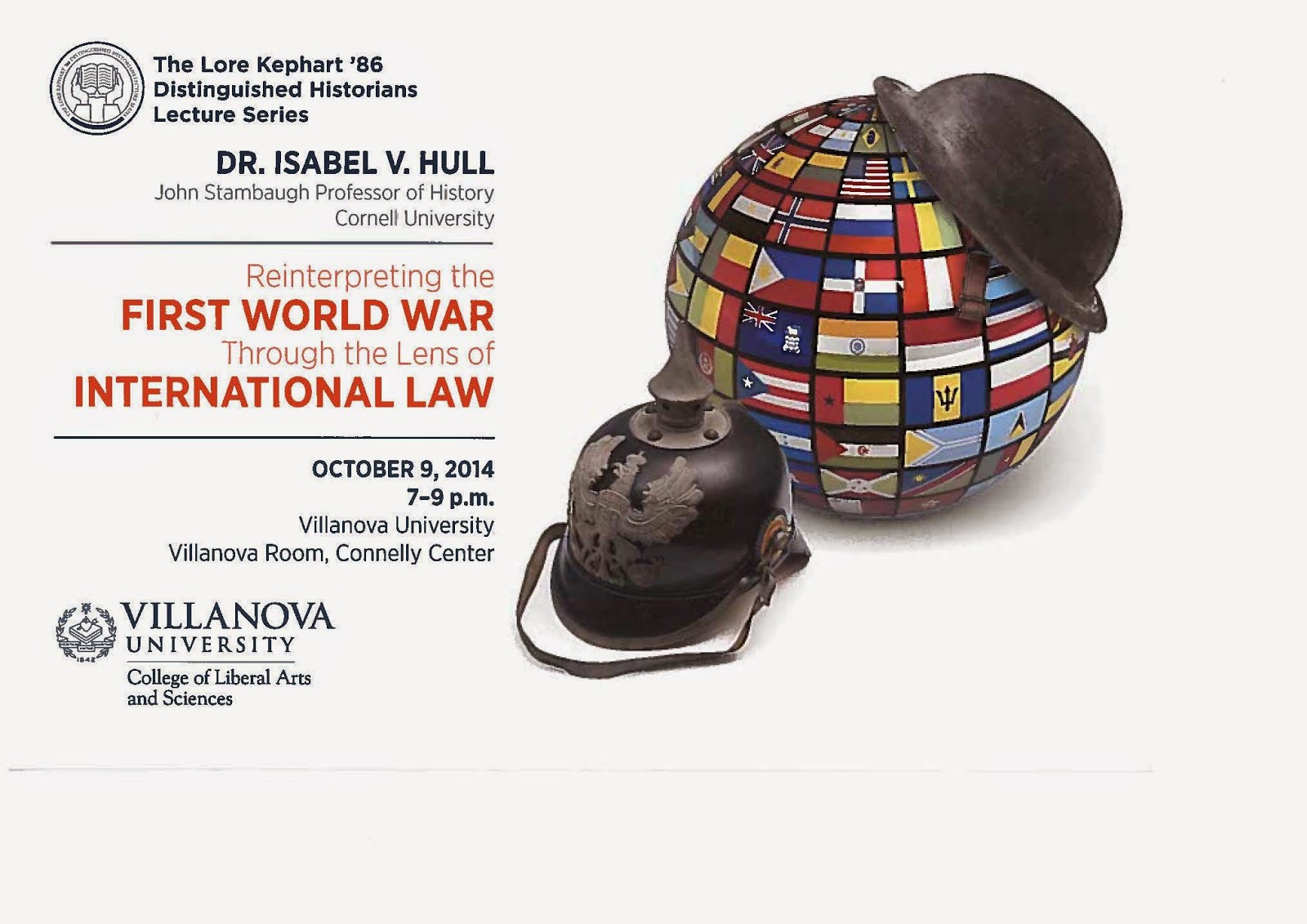It has been my privilege, through the years, to share word of the annual lecture series created by my father and Villanova University
in memory of my mother, Lore Kephart. My mother was, herself, a distinguished woman—not just a graduate of Villanova and a writer, but a woman of great intelligence and grace who also (with enviable ease) served dinners no one who ever ate them will forget.
My mother would have deeply appreciated the time that the Villanova team, together with my father, put into selecting Dr. Isabel V. Hull, Stambaugh Professor of History at Cornell University, as this year's honored guest. Dr. Hull has two degrees from Yale University in History, as well as an undergraduate degree from the University of Michigan. At Cornell she teaches courses with titles like "The International Laws of War," "The First World War: Causes, Conduct, Consequences," and "History of Liberalism." She is a member of the American Academy of Arts and Sciences, a John Guggenheim Fellow, and an Alexander von Humboldt-Stiftung Research Fellow.
This year Dr. Hull published her new book,
A Scrap of Paper: Breaking and Making International Law in the First World War, which Samuel Moyn, writing in the
Wall Street Journal, wrote: "is a strong demonstration of the worth of international law and the laws of war in particular, and vindicates Ms. Hull's standing as one of our greatest historians of modern European politics."
It is this book that will form the basis of Dr. Hull's talk at Villanova University on October 9, starting at 7 o'clock. The event is free and open to the public. The Kephart family and Villanova University extend a warm invitation.
From my cousin Libby, earlier today, this bit of family history, posted on the Cornell University news site. I didn't know this. I probably should have. I find it especially interesting today, as I finish reading the new Matt Higgins book Bird Dreams: Adventures at the Extremes of Human Flight, a magnificent chronicling of the men (and women) who choose to jump from planes, buildings, antennae, and cliffs, some wearing nothing more than flying-squirrel-shaped suits.
What people will do. What they can do. And apparently Leonard Kephart, my grandfather's brother, chose to scale Africa's great mountain all in a hunt for new glasses, and clover.
Aug. 30, 1927 Leonard W. Kephart, Class of 1913, is the first American to scale Mount Kilimanjaro, Africa's highest peak. He was in Africa on a search for new grasses for the U.S. Department of Agriculture. Kephart took four days to reach the peak, slogging through snow-covered gravel the last day. The climb was not entirely without scientific reward, reported the Cornell Alumni News (Nov. 10, 1927). Kephart discovered three new varieties of clover on the expedition.
Leonard (pictured standing with my grandfather and great aunts (and Laura Mack)) was one of his six children born to Horace Kephart, the librarian-turned-outdoorsman who helped found the Great Smoky Mountains National Park. I've written about Horace
here. But just moments ago, I found this lovely biography on the
Horace Kephart Alaska Center Weblog.I learn so much from those who do history well.
I have written, on this blog, of my great grandfather, Horace Kephart, who left a career as one of the nation's great librarians and left a family, too, to live among the private beauties of the Appalachian Mountains and people. Horace Kephart documented Appalachian ways and campfire know-how. He was in part responsible for the creation of the Great Smoky Mountains National Park. He has been the subject of songs (see Daniel Gore's
beautiful song cycle), movies (the
recent Ken Burns' documentary), novels, and myths. He is also, thanks in large part to my cousin Libby Kephart Hargrave and the great historian George Ellison, celebrated in the annual
Horace Kephart Days, held each year between April 29 and May 1st in Bryson, City, NC.
George Kephart, my grandfather, was one of Horace Kephart's two sons. When his father departed for his Appalachian journey, George moved, with his mother, Laura, and his five total siblings, to Ithaca, New York. All six Kephart children ultimately attended Cornell University, while Laura took in boarders to try to make ends meet.
Toward the end of his life, George Kephart made two important decisions: to
leave his own papers to Cornell University and to dedicate a glen in his wife's name within the
Cornell Plantations.
This weekend I saw those plantations for the first time. With my husband and son, through mist then heavy rain, I searched for the glen. There was hardly anyone about, and no one to ask, and if I never found the glen itself, if I will have to return with a guide (and I will), I did discover the tremendous beauty of this place—even in rain, even before most any flower has had a chance to bloom. This is peaceful, water-streaming, well-considered country. This is ravines and slopes and green, a tumble of hellebores. My grandfather was a quiet man, a forester, a rose gardener, a lover of things alive and growing. No wonder, I kept thinking as I walked. No wonder this place was his eternity.









Fascinating story, and beautiful photographs. Have you written a biography of him?
Oh, that's amazing! I love the Cornell Plantations. I went to school at Cornell. Actually I just wrote a blog post about it because I've been feeling nostalgic for Ithaca. Next time I visit the campus, I will have to wander around to find the Kephart Glen...though maybe I'll need a serious map?? :-)